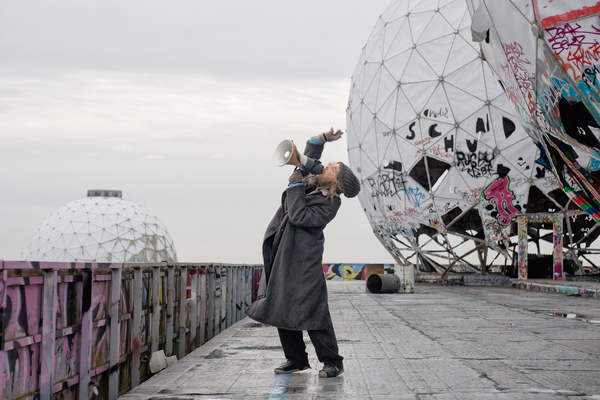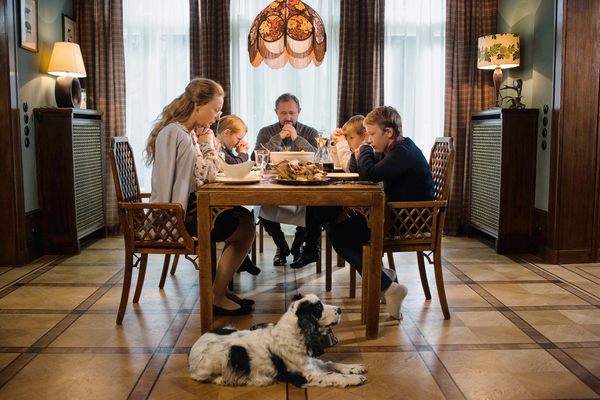MANIFESTO: Film vs. Installation
Last week I went to the first screening of Julian Rosefeldt's Manifesto, live-streamed from Tate Modern in London. After seeing the original art installation in Berlin two years ago I was understandably excited and intrigued by this release.
The original installation consisted of 13 screens, each projecting a different 10 minute long film starring Cate Blanchett as a different character. Each of these characters were imagined by Rosefeldt and herself, and each give life to a different manifesto from art history's most interesting groups of people, sometimes combining multiple manifestos - for example those of Barnett Newman and Wassily Kandinsky - to create more engaging and contradictory scripts.
 |
| installation in Berlin |
The question of how to turn a 13 screen installation into one feature length film was one I pondered for several days before the screening, unsure if Rosefeldt would be able to do the original installation justice by reducing it to a single screen.
Understandably the original films had to be condensed - to show each one back to back just would not have made sense as a feature length film. Saying that, the film opens with the same video that you would see first in the installation, a close up of the fuse of a firework slowly burning across the screen with Blanchett's voice over the top reciting a combination of manifestos from the 1920s and 30s including that of Carl Marx, the Dada movement and the John Reed Club of New York: "An old world is dying; a new one is being born."*
Cut to three elderly women lighting the fireworks in daytime and running away giggling and laughing as they fly up into the sky with high-pitched wails. The camera then pans out to include the figure of a homeless man walking a dog and dragging a suitcase, following him as he walks through the ruins of an old fertilisation plant outside Berlin. Queue the opening credits. Once he reaches the roof of one of the buildings and begins his speech, we realise that yes, this too is Cate Blanchett.
Before this scene is finished (in relation to what is shown in the installation) we move on to a different environment, this time computer screens in their hundreds - a broking office - slowly zooming in on their operators from above before cutting to Cate Blanchett talking on the phone, pen in hand, but again it is a voiceover that we listen to in order to hear the next set of manifestos - this time in relation to Futurism.
Moving on to a worker in a garbage incineration plant and manifestos relating to architecture, then to Blanchett as a CEO at a private party and the first audience laugh as this very posh character makes a comment about rich people before proceeding to greet her guests as 'darling' - funny in its contradiction. We then have Blanchett as a tattooed punk, then a scientist, then a funeral goer, a puppeteer, a conservative mother, a choreographer, a news reporter and as a teacher covering movements such as Dada, Fluxus, Minimalism, Pop Art, Constructivism and Surrealism amongst others in turn, whilst also jumping back to previous scenes rather than follow on one after an other.
This technique worked particularly well for the scene of Blanchett as a conservative mother saying grace at the dinner table with her husband and three sons - making it seem like she had been talking for ages and ages about what kind of art she was 'for' - see Claes Oldenburg's I am for an Art... from 1961 if you want some insight.
The film ends with the 12 characters filling the one screen much like the wall outside the exhibition in Berlin, all speaking at once before disappearing one by one leaving the homeless man to both start and finish the manifestos.
So is it better as a film or an installation?
With stunning architectural cinematography, the film is beautiful to watch, but unlike in the installation you can't walk away from a video if it's not tickling your fancy. This caused me to nearly fall asleep twice as you're forced to sit through manifestos and characters you may not necessarily connect with - and it wasn't just me that had this problem, a gentleman in the same screening fell fully asleep for a good twenty minutes at one point.
Despite the humour coming through more with the play of timing and cutting scenes and jumping back in as with the conservative mother or the scientist - I do feel like something is lost in not getting the whole sequence, the whole 10 minutes originally made for each character. Plus there's something really magical about multiple screen projections for me - or maybe I'm just partial to multiple videos at once?
Regardless, Manifesto is in my opinion better suited to being an art installation than a feature film.
If it tours again as an installation I'd definitely consider going to see it again rather than the film, as visually enticing as it is - nothing is going to convince me to sit through that 90 minutes again.
Did you see Manifesto in either of its forms?
Let me know what you thought
- Melissa x
* Draft Manifesto - John Reed Club of New York (1932)




